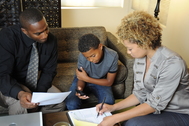Prepare
Your Home for Wildfire
 Where there is
smoke, there could be fire! Wildfires can occur anywhere, any time of the
year, and destroy homes, businesses, and natural resources. Where there is
smoke, there could be fire! Wildfires can occur anywhere, any time of the
year, and destroy homes, businesses, and natural resources.
According to the National Fire
Protection Association’s Firewise Communities Program, more than
$1.9 billion was spent on wildfire suppression in 2016.
However, you can
prepare yourself, your business, and where you live in the event you may
experience a wildfire emergency. Get started by:
·
Watching the
Federal Emergency Management Agency’s wildfire animation – When the Fire
Starts.
·
Reviewing
your homeowner’s or renter’s insurance policy to ensure you have the adequate
coverage for your property and personal belongings.
·
Removing
flammable items, such as firewood piles and portable propane tanks, within 30
feet of all structures and discarding any dry or dead vegetation from up to
100 feet around your home.
·
Learning and
practicing evacuation routes from your home or business to an area that is
not affected by the wildfire. The best action to protect yourself and your
family is to evacuate early and avoid being trapped.
Wildfires can occur any time of the
year, but are especially prevalent during the dry season. Make sure you
prepare ahead of time by checking out Prepareathon's
How to Prepare for a Wildfire Guide.
|
Preparedness
for Parents
 Have you heard? National
Parents’ Day is Sunday, July 23. In observance of this
occasion, we encourage family members to help parents prepare for
emergencies. Prepareathon and the Ready Campaign highlight several ways
to prepare for the unexpected. Have you heard? National
Parents’ Day is Sunday, July 23. In observance of this
occasion, we encourage family members to help parents prepare for
emergencies. Prepareathon and the Ready Campaign highlight several ways
to prepare for the unexpected.
Some of these actions include:
·
Creating a
family emergency communication plan - Your family may not
be together when disaster strikes, so it is important to plan for how
you will connect with each other.
·
Preparing infants and
young children for emergencies - Learn the emergency
plans for their daycare or school.
·
Getting
college-age kids Campus Ready
- Gather information on the emergency procedures for their school or dorm.
·
Practicing
your emergency response plan - Making emergency plans is
great, but practicing your plan by conducting drills will help your
family’s response time when seconds count.
Disasters can be stressful for kids.
Try to make emergency planning fun for children in your family. Visit www.ready.gov/kids for
exciting games, quizzes, and other resources to help young children and teens
understand the importance of emergency preparedness.
|
Preparedness
for People with Disabilities and Others with Access and Functional Needs
 The 27th
anniversary of the Americans with
Disabilities Act is Wednesday, July 26. Individuals and caregivers
for people with disabilities and others with access and functional needs are
encouraged to evaluate their necessities in the event of an emergency and
create an emergency plan unique to them. The 27th
anniversary of the Americans with
Disabilities Act is Wednesday, July 26. Individuals and caregivers
for people with disabilities and others with access and functional needs are
encouraged to evaluate their necessities in the event of an emergency and
create an emergency plan unique to them.
The Ready
campaign shares several easy ways to create an emergency plan tailored for
specific needs:
·
Collect
information – Create a paper copy of
the contact information including phone, email, and social media
information for your family, friends, caregivers, neighbors and other
important people or service providers.
·
Share your
emergency plans – Tell your employer and trusted
people in your support networks where you keep your emergency supplies, what
you need, and how to contact you if the power goes out.
·
Practice Your
Plan – Dedicate time to practice your
emergency plan with your support network, just as you would with a fire
drill.
For more great information on how to
make your emergency plan, visit Ready’s Individuals
with Disabilities page.
This information is from the FEMA's Individual and Community Preparedness e-Brief for July 20, 2017.
|
No comments:
Post a Comment